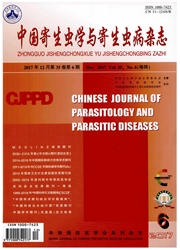

 中文摘要:
中文摘要:
目的 采用分子生物学方法鉴定云南省疟疾参比实验室镜检疟原虫疑难血样。方法 选取2012年8月-2015年4月云南省疟疾疫情报告病例中疟原虫形态学鉴定疑难血样,对其18srRNA基因进行巢式PCR扩增和产物测序,测序结果在NCBI和Mega6.06软件与4种疟原虫参比虫株序列(恶性疟原虫P.falciparum:KC906781;间日疟原虫P.vivax:X13926;三日疟原虫P.malariae:M54897;卵形疟原虫P.ovale:L48987)进行相似性和同源性分析。结果38份疑难血样中,采自缅甸感染、云南感染、非洲感染者的血样分别为81.58%(31/38)、15.79%(6/38)和2.63%(1/38)。12份P.malariae及感染红细胞的镜检形态特点为:疟原虫体积占红细胞的体积〉1/4,可见不同发育期的疟原虫形态,但同时可见“带状”滋养体、“梅花状”裂殖体典型形态的仅有4例,占33.33%(4/12),“带状”滋养体、“梅花状”裂殖体单独可见的比例分别为83.33%(10/12)和75.0%(9/12),100%(12/12)的疟原虫感染红细胞体积不胀大或略为缩小。5份P.ovale及感染红细胞的镜检形态为:疟原虫体积占红细胞的体积〉1/4,可见各期疟原虫,红细胞体积正常或缩小的发生率为100%(5/5),红细胞呈伞矢状、拖尾、红细胞边缘呈刺突变形的比例分别为80%(4/5)、100%(5/5)和80%(4/5)。11份可疑为P.vivax的形态仅剩疟色素样或疟原虫细胞核样物体。10份P.falciparum的形态不同于以往云南省常见的疟原虫胞浆、胞核纤细、致密的恶性疟原虫,胞浆粗大,虫体占红细胞体积的三分之一。上述血样经18S rRNA基因PCR扩增和DNA测序分析,阳性符合率为100%(38/38),4种疟原虫的18SrRNA基因DNA序列与4种参比序列的相似性在81%~100%之间,也与各自的参比序列聚类成彼此分离的进化分枝,即序列分类与形态识别结果吻合。结论 云南省的输入性三日疟、卵形疟病例时有发生,对疑难形态疟原虫的虫?
 英文摘要:
英文摘要:
Objective To use molecular biology techniques to identify reference strains of Plasrnodium from Yunnan that microscopy cannot readily identify in blood samples. Methods Blood samples and smears from malaria cases repor- ted in Yunnan were collected from August 2012 to April 2015. Nested-PCR and DNA sequencing approaches were used to identify the 18S rRNA gene in blood samples if the morphology could not be readily identified in smears. The NCBI database and the software Mega 6.06 were used to test samples for their similarity and homology to four reference strains of Plasmodium spp. (P. falciparurn: KC906781; P. vivax: X13926; P. malariae: M54897; P. ovale: L48987). Results Of 38 patients with suspected malaria, 81.58% (31/38) were infected in Myanmar, 5.79%(6/38) were infected in Yunnan, and 2.63% (1/38) were infected in Africa. Microscopic examination of samples from the 12 cases of P. malariae revealed the following features: plasmodia accounted for over 1/4 of the volume of erythrocytes and plasmodia in different stages of development were evident. However, band-form trophozoites and rosette schizonts were both seen in only 4 cases, accounting for 33. 33% (4/12) of all cases. Band-form trophozoites alone were seen in 83. 33% (10/12) of cases and rosette schizonts alone were seen in 75.0% (9/12). Plasmodia had not increased or decreased the volume of in- fected erythrocytes in any of the cases (100%, 12/12). In the 5 cases involving P. ovale, plasmodia accounted for over 1/4 of the volume of erythrocytes and plasmodia in different stages of development were evident. The volume of infected erythrocytes was normal or smaller in 100% of the cases (5/5). Erythrocytes had pointed edges in 800/oo of cases (4/5), erythrocytes left streaks in 100% of cases (5/5), and erythrocytes had jagged edges in 80% of cases (4/5). In 11 cases suspected of involving P. vivax, malaria pigment-like material and Plasmodium nuclei were noted. In the 10 cases involving P. falcip
 同期刊论文项目
同期刊论文项目
 同项目期刊论文
同项目期刊论文
 期刊信息
期刊信息
